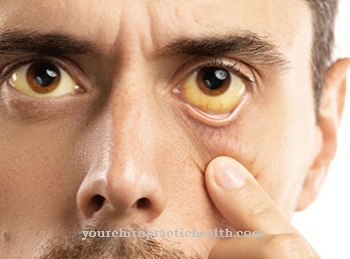A Bladder exstrophy emergency medical treatment is usually required for newborns. Despite successful therapeutic steps, symptoms can occur for a lifetime.
What is a bladder exstrophy?

© bilderzwerg - stock.adobe.com
Bladder exstrophy is an already congenital malformation that occurs comparatively rarely. Bladder exstrophy occurs in approximately one in 10,000 to 50,000 newborns. As a rule, boys are more often affected by the malformation than girls.
The main visible symptoms of bladder exstrophy include a urinary bladder that is open to the outside of the body. In those affected by bladder exstrophy, the mucous membrane of the urinary bladder merges with the skin of the anterior abdominal wall. In both girls and boys, bladder exstrophy is usually accompanied by a split in the urethra.
In addition to the urethra and bladder, in most cases the external genitalia (sexual organs) and the pelvis are also impaired by the developmental disorder. In urology (a medical specialty that deals with the urinary tract, among other things), bladder exstrophy is a serious defect.
causes
Symptoms of bladder exstrophy are usually caused by impaired development of the lower abdominal wall of an affected fetus. As part of this undesirable development, for example, associations of abdominal muscles or the bones of the pelvis are impaired.
As a result, the abdominal wall ruptures (a breakthrough) through which the urinary bladder penetrates to the outside. The frequent consistent dripping of urine from the urinary bladder, which is impaired by bladder exstrophy, is usually caused by a lack of contact between the bladder neck (the junction between the urinary bladder and urethra) and the urinary bladder sphincter.
This lack of attachment is also a consequence of the embryonic developmental disorder. The causes of bladder exstrophy are still largely unknown - but both environmental and genetic factors probably play a role.
Symptoms, ailments & signs
Bladder exstrophy is primarily noticeable through the urinary bladder that is visible from the outside. Usually part of the split urethra is also exposed. This leads to leakage of urine and occasionally infections.
A malformation of the urinary bladder can be diagnosed quickly on the basis of the clear external signs and the symptoms mentioned and, as a rule, treated directly. If this happens early enough, there will be no further complaints. If left untreated, bladder exstrophy can cause a number of other symptoms. These include urinary incontinence, infections of the bladder and genital organs, and chronic pain in the area of the malformation.
In some patients, the urine backs up, which can cause kidney damage. Such a back pressure is initially expressed by increasing pressure pain and urinary retention. As the disease progresses, cramps and fever may occur. Bladder exstrophy can also affect sexual functions.
This manifests itself, for example, through erectile dysfunction up to erectile dysfunction. In the course of an untreated bladder exstrophy, there is a risk that emotional complaints will develop. Problems such as depression or social anxiety often arise in childhood and represent a considerable burden for both those affected and their relatives.
Diagnosis & course
The suspected diagnosis of bladder exstrophy can occasionally be made during prenatal (prenatal) examinations using ultrasound. Such a suspicion is based, for example, on the fact that an insufficiently filled bladder of the fetus has repeatedly been detected.
If the prenatal diagnosis is not made, bladder exstrophy is usually recognized at birth based on the characteristic symptoms. The individual course of a bladder exstrophy is influenced, among other things, by the success of therapeutic measures.
Failure to properly treat the developmental disorder can result in complications such as urinary incontinence (lack of control over the retention of urine), backlogs of urine in the kidneys, frequent inflammation of the urinary and genital system or sexual dysfunction. Corresponding consequential damages are occasionally also possible in successfully treated patients.
Complications
Bladder exstrophy in newborns is a urological emergency. The more time elapses before the first surgical reconstruction, the greater the risk of later complications. Due to the defect of the anterior abdominal wall, an infection with pathogenic microorganisms can occur with bladder exstrophy. In the worst case, there is a risk of sepsis (blood poisoning) immediately after the birth. Prophylaxis with antibiotics is therefore mandatory from the first day of life.
Surgical restoration of urinary continence is the focus of further treatment of bladder exstrophy. If the incontinence is not adequately corrected, chronic skin irritation can occur. These often lead to superinfections with Candida albicans and other fungi.
In addition to sexual dysfunction, the long-term consequences of successful operations are above all recurrent inflammation in the urogenital region and a backlog of urine in the kidneys. Regular checks ensure an early diagnosis of metabolic diseases and serve to identify the development of cancer.
Due to the anatomical relationships between the vagina and uterus, women born with bladder exstrophy are more likely to become pregnant. Due to the loosening (diastasis) of the pubic symphysis and the changed pelvic floor muscles, there is a risk of uterine prolapse. In order not to jeopardize the results of previous operations, doctors always recommend delivery by caesarean section (elective cesarean section).
When should you go to the doctor?
Usually, bladder exstrophy is diagnosed during an ultrasound scan during pregnancy or immediately after giving birth. The malformation must be treated immediately, otherwise the child may die. After the operation, further surgical interventions and visits to the doctor are usually required. Parents should consult their family doctor or pediatric urologist regularly so that they can react quickly to any complications.
Further medical examinations are necessary if the incontinence leads to infections and other symptoms. If you have psychological complaints, you should go to a doctor with the affected child. Often times, the quality of life can be improved through further surgical measures and cosmetic interventions.
At the same time, the doctor will refer the person concerned to a therapist or a self-help group. The detailed measures to be taken depend on the severity of the bladder exstrophy and the physical and emotional effects. Early consultation, ideally during pregnancy, can optimize treatment and largely rule out complications.
Doctors & therapists in your area
Treatment & Therapy
Promising medical treatments for bladder exstrophy usually take place surgically. Bladder exstrophy is an emergency in urology.
According to international guidelines, the urinary bladder must initially be closed surgically and the abdominal wall stabilized in the affected child within 24 to 72 hours after birth. As a rule, further operations follow in the later years of a child suffering from bladder exstrophy; The goals of such interventions include regaining voluntary control of the bladder function (urinary continence) and maintaining healthy kidney functions.
Since the genital organs are usually also impaired by a bladder exstrophy, further possible interventions also aim to restore the corresponding organs; these restoration measures can be carried out on both a functional and a cosmetic level.
In most cases, bladder exstrophy ultimately requires lifelong, regular check-ups. Above all, these examinations serve to identify possible secondary diseases of bladder exstrophy at an early stage. These secondary diseases include, for example, metabolic disorders or the development of carcinomas (malignant tissue growth) on the mucous membranes of the lower abdomen.
Outlook & forecast
The chances of recovery from bladder exstrophy depend on the severity of the disease, the start of treatment and the general health of the patient.
If there are no other disorders or illnesses, the newborn will normally undergo an operation within the first two days of life. The malformation of the bladder is corrected as much as possible. Only in a few patients is a single corrective intervention sufficient to cure or alleviate the symptoms. In most cases, further operations follow as the growth and development process progresses. In these, an attempt is made to create the physical conditions for voluntary bladder control.
Since the genital organs are often damaged in a bladder exstrophy, these too are subjected to corrective treatment in the first years of life up to adulthood. Any surgery comes with the usual risks and side effects. The consequence of this is that the patient is exposed to severe stress several times over the first 20 years of his life, from which he has to recover.
The more stable the health and the stronger the immune system, the better and faster the individual interventions can heal. If the patient goes without the corrections, he will suffer from urination problems and sexual dysfunction for life. If the interventions take place with optimal results, you can largely achieve freedom from symptoms.
prevention
Since medicine has so far little knowledge of the causes of the formation of a bladder exstrophy, the disease can hardly be prevented.
The severity of complaints, complications and possible secondary diseases in connection with bladder exstrophy can, however, be positively influenced by early and consistent treatment steps. Logically, women should completely refrain from smoking, alcohol and drugs during pregnancy in order to avoid malformations of the child.
Aftercare
After the bladder exstrophy has been surgically corrected, various follow-up measures apply. The patient must first spend a few hours in the recovery room in order to identify and treat complications in good time. The doctor will regularly check your blood pressure and pulse, and will also make sure that the sutures are healing properly. If there are no abnormalities in this phase, the patient can be discharged.
First of all, however, the person concerned receives medical recommendations for taking painkillers and sedatives. Bladder exstrophy can lead to complications for some time after the procedure, which must be clarified by a doctor. A visit to the doctor is recommended, for example, in the event of inflammation, itching or bleeding in the area of the surgical scar.
In addition, follow-up appointments agreed with the surgeon must be observed. General measures such as drinking enough (especially mineral water and tea), abstaining from alcohol and nicotine and avoiding strong sunlight in the area of the scars are essential.
With a fresh seam, you should also avoid the shower for seven to nine days. If there are no complications, no further follow-up is required. However, patients with bladder exstrophy often suffer from other illnesses, which is why a regular visit to the urologist is recommended.
You can do that yourself
The malformations in the area of the urinary bladder that exist from birth as part of bladder exstrophy can only be treated by medical interventions, so that no direct measures for self-help can be applied. However, patients and their custodians support the medical treatment by adopting behavior that is usually adapted to surgical interventions.
Usually, the newborn patient undergoes an operation within the first few days of life to compensate for the deformity. Constant medical monitoring of the newborn is essential, whereby parents always adhere to the instructions of specialists and clinic staff.
In many cases, further surgical interventions are required before patients with bladder exstrophy reach adulthood. The aim of these operations is to ensure urinary continence and, if necessary, to reconstruct the genital organs. With regard to continence, the patients support the success of the therapy through physiotherapy, which strengthens the corresponding muscles in the lower abdominal area. Such exercises can be performed at home.
As long as the urinary continence is not given, the patients are often dependent on diapers. Suitable models are discreet so that they are hardly noticeable from the outside and do not disturb those affected in their normal everyday life as much as possible. Thus, despite bladder exstrophy, patients are able to take part in social life and minimize restrictions caused by incontinence.






.jpg)






.jpg)

.jpg)
.jpg)











.jpg)